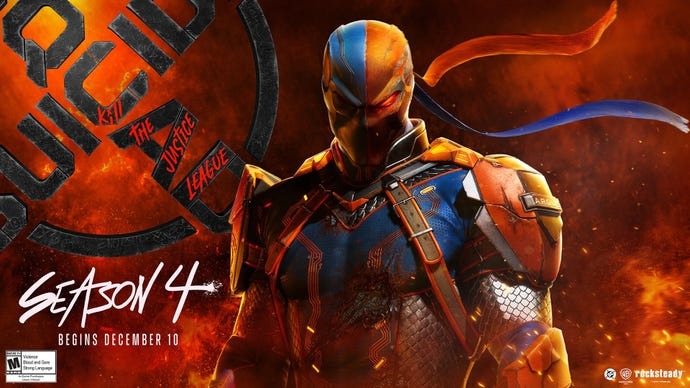Suicide Squad: Kill the Justice League’s Roadmap is Finally Coming to an End with Deathstroke, and After an Incredibly Rough Year, Presumably the End of New Updates. This conclusion to the game’s roadmap signifies not only the culmination of its promised content but also a potential end to further development efforts, leaving fans and critics reflecting on what has been a contentious chapter in the gaming industry.

As the final piece of the puzzle falls into place, the spotlight turns to how the game navigated its hurdles, what this update entails, and what it means for the legacy of Suicide Squad: Kill the Justice League. For those invested in the title, whether through initial excitement or enduring frustration, this moment represents both closure and an opportunity to evaluate its place in gaming history.
The Development and Release – A Rollercoaster of Expectations
The journey of Suicide Squad: Kill the Justice League began with immense anticipation. As a project helmed by Rocksteady Studios—the team behind the acclaimed Batman: Arkham series—the game carried high expectations from its very announcement. Promising a unique blend of narrative depth, action-packed gameplay, and cooperative multiplayer elements, it was positioned as a must-play title for fans of the DC Universe and action games alike.
However, the reality of its release painted a starkly different picture. Plagued by delays, technical issues, and lukewarm reception to its live-service model, the game struggled to meet the lofty standards set by its predecessors. The decision to incorporate microtransactions and battle pass elements drew criticism, overshadowing the title’s narrative and gameplay achievements.
The disappointment culminated in significant backlash following its launch, with players expressing dissatisfaction over its repetitive gameplay loops and lack of meaningful content. Despite efforts to address these concerns through patches and updates, Suicide Squad: Kill the Justice League never fully recovered its footing, leaving its roadmap as both a promise and a burden.
Deathstroke’s Arrival – The Final Chapter
The decision to center the final update around Deathstroke—a fan-favorite character in the DC Universe—carries significant weight. Known for his complex backstory, tactical brilliance, and formidable combat skills, Deathstroke has long been a staple in the world of DC villains. His addition to the game not only expands its roster but also serves as a symbolic farewell, encapsulating the narrative and gameplay ambitions that defined Suicide Squad: Kill the Justice League.
This update introduces a new storyline revolving around Deathstroke’s pursuit of power and revenge, along with gameplay features designed to showcase his unique abilities. Players can expect a blend of stealth, strategy, and high-octane action, reflecting Deathstroke’s status as one of the most skilled assassins in the DC Universe.
In addition to the new content, the update includes bug fixes, quality-of-life improvements, and balancing adjustments aimed at enhancing the overall experience. While these changes are unlikely to win back disillusioned players, they underscore Rocksteady’s commitment to fulfilling its promises, even as the game’s lifecycle nears its conclusion.
The Year That Was – Challenges and Lessons
The past year has been anything but smooth for Suicide Squad: Kill the Justice League. From its controversial reveal to its rocky post-launch phase, the game’s trajectory has been a cautionary tale for developers navigating the ever-evolving landscape of modern gaming.
One of the most significant challenges lay in balancing the demands of a live-service model with the expectations of a narrative-driven experience. While live-service elements such as seasonal updates and cosmetic items are increasingly common, their implementation in Suicide Squad: Kill the Justice League felt at odds with the game’s core identity. Players who sought a story-rich, immersive experience were left disappointed by the emphasis on grind-heavy mechanics and monetization strategies.
Moreover, the technical performance of the game was another sore point. Reports of crashes, frame rate drops, and graphical glitches marred the experience for many players, detracting from the immersive world that Rocksteady sought to create. Although subsequent patches addressed some of these issues, the damage to the game’s reputation was difficult to undo.
Examining the Roadmap – A Mixed Legacy
The roadmap for Suicide Squad: Kill the Justice League was ambitious, promising a steady stream of content designed to keep players engaged. However, its execution left much to be desired. While some updates introduced worthwhile additions, others felt like filler, offering little in the way of meaningful progression or excitement.
This uneven approach to content delivery contributed to the game’s struggles in retaining its player base. A look at player engagement metrics reveals a sharp decline in activity just months after release, highlighting the challenges of maintaining interest in a live-service game that fails to resonate with its audience.
| Roadmap Phase | Key Features | Reception |
|---|---|---|
| Initial Launch | Core campaign, multiplayer modes | Mixed; praised narrative, criticized live-service model |
| Early Updates | Seasonal events, cosmetic packs | Lukewarm; perceived lack of value |
| Mid-Year Content | New missions, expanded customization options | Improved, but still divisive |
| Final Update (Deathstroke) | New character, storyline, gameplay elements | TBD; anticipated closure |
What Lies Ahead
As Suicide Squad: Kill the Justice League reaches the end of its roadmap, questions about the future of Rocksteady Studios and the broader DC gaming universe abound. While the studio’s reputation has taken a hit, its talent and legacy as a developer remain undeniable. Moving forward, the lessons learned from this project will undoubtedly shape its approach to future titles, particularly in balancing creative vision with player expectations.
For fans of the DC Universe, the closure of Suicide Squad: Kill the Justice League marks a bittersweet moment. While the game may not have lived up to its potential, it offered glimpses of what could be achieved when iconic characters and compelling narratives are brought to life in the gaming medium.
In the end, the story of Suicide Squad: Kill the Justice League is one of ambition, missteps, and resilience—a reminder of the challenges inherent in creating something truly innovative. As the final update rolls out, players and developers alike are left to reflect on what this chapter means for the future of gaming.










Add Comment